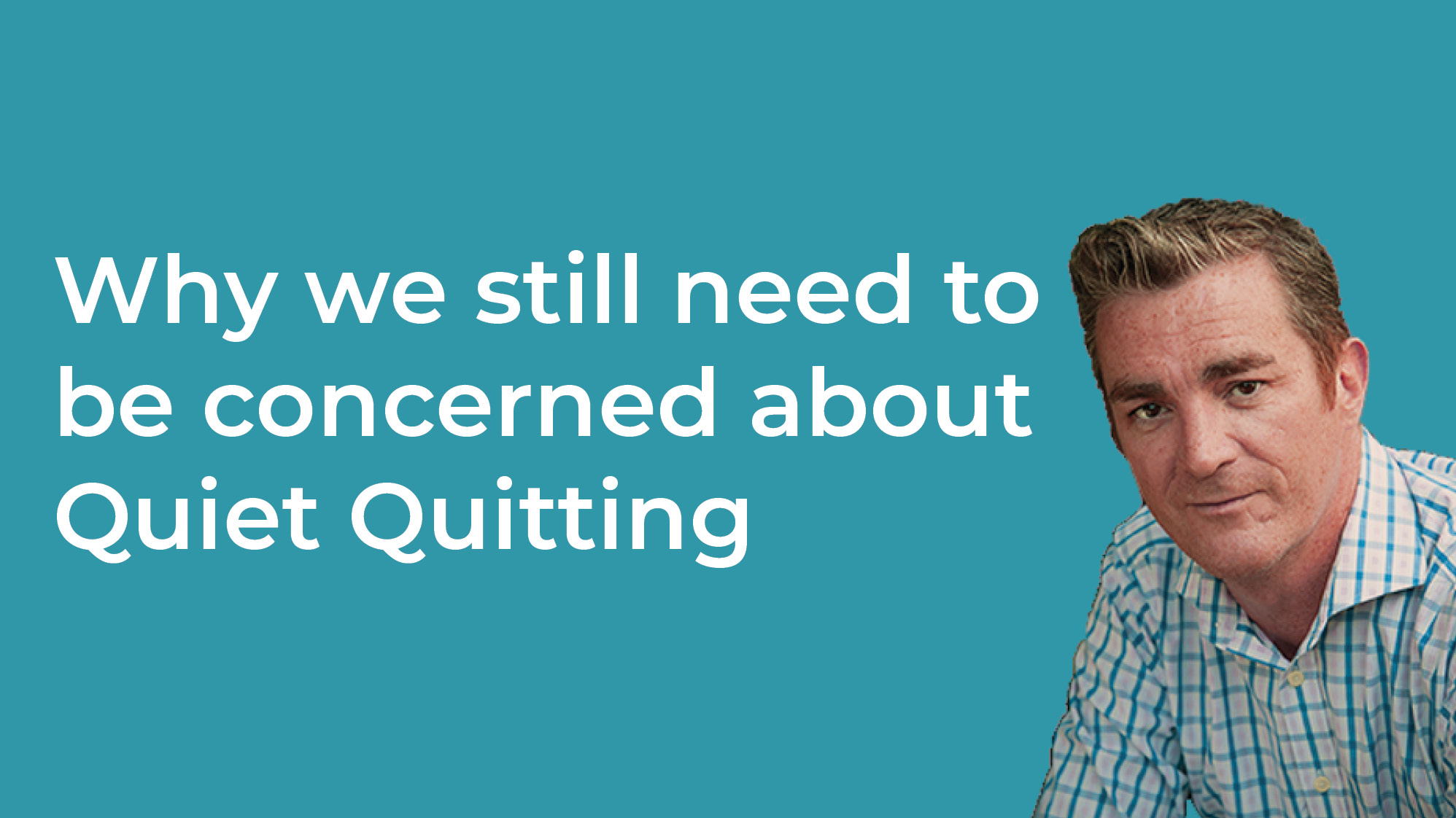Why we still need to be concerned about Quiet Quitting

The concept of quiet quitting
Quiet quitting, a phenomenon that has gained traction in recent years, refers to the silent disengagement of employees from their work and organisation. It is a form of resignation that occurs without any overt signs of discontent or intention to leave. As employees become increasingly dissatisfied or unfulfilled in their roles, they often choose to disengage quietly, leading to a decline in productivity, motivation, and overall organisational effectiveness. In this article, we will delve into the concept of quiet quitting, exploring its historical context, prevalence in the modern workplace, underlying causes, impact on organisations and individuals, methods of identification, and strategies to address and prevent its occurrence. By shedding light on this often overlooked issue, we aim to provide insights that can help organisations foster a culture of engagement, retention, and employee well-being.
Understanding the concept of quiet quitting
We’ve all been there – that feeling of being stuck in a job you don’t love, fantasising about dramatic “I quit” moments. But what about those who silently exit the stage without any fanfare? Enter the realm of “quiet quitting,” a phenomenon where employees disengage from their work and leave their jobs without causing a ruckus.
Understanding the origins of quiet quitting
Quiet quitting is not a new concept. For many years, people have been silently slipping away from their roles when dissatisfaction reached its peak. From workers in the industrial revolution deserting their jobs under the cover of darkness to office employees discreetly sending their resignation emails, the art of quiet quitting has evolved. By understanding its historical context, we can better grasp its significance in the present workplace.
While the methods of communication may have changed, the underlying reasons for quiet quitting remain similar.
The prevalence of quiet quitting in the modern workplace
Quiet quitting may sound like an urban legend, but the numbers tell a different story. Numerous studies have shed light on the prevalence of this phenomenon. Surprisingly, it’s not as rare as one might think. Employees disengaging from their work quietly and exiting without making a fuss is more common than one might expect.
Quiet quitting is not limited to a specific industry or job role. It can be found across various sectors, from entry-level positions to the C-suite. Whether it’s an uninspiring work environment, a toxic corporate culture, or a perceived lack of growth opportunities, employees silently waving goodbye is a widespread occurrence. Let’s dive into some common scenarios that illustrate this phenomenon across industries.
Factors contributing to quiet quitting
Lack of job satisfaction and fulfilment
One of the primary factors behind quiet quitting is a lack of job satisfaction and fulfilment. When employees feel unengaged, undervalued, or unfulfilled in their roles, they may opt for a quiet exit rather than making a scene. Recognising the importance of employee satisfaction and addressing these concerns is essential in reducing the occurrence of quiet quitting.
Ineffective communication and leadership
Poor communication and ineffective leadership can also push employees towards the path of quiet quitting. When employees feel disconnected from their managers, receive vague instructions, or lack the necessary guidance and support, they may silently check out and search for greener pastures.
Burnout and excessive workload
Excessive workload and burnout can wear down even the most dedicated employees. When overwhelmed, some individuals may choose to silently quit rather than endure the exhaustion and stress that comes with an unsustainable work environment.
Limited growth and development opportunities
Employees crave opportunities for growth and development. If these avenues are limited or non-existent, they may quietly quit and seek organisations that provide the chance for professional advancement. Creating an environment that fosters growth can help retain talent and reduce the incidence of quiet quitting.
The impact of quiet quitting on organisations and individuals
Quiet quitting, the silent departure of disengaged employees, can have significant repercussions for both organisations and individuals. It’s crucial to understand the effects it can have on team morale, productivity, and individual career growth and well-being.
Effects of quiet quitting on team morale and productivity
When employees quietly disengage and lose motivation, team morale can take a hit. The lack of enthusiasm and energy can spread like wildfire, dampening the overall spirit and camaraderie within the team. As a result, productivity may decrease, hindering an organisation’s ability to achieve its goals.
Consequences for individual career growth and well-being
For individuals, quietly quitting a job can have long-term consequences for their career growth and personal well-being. By disengaging and not giving their best effort, employees miss out on opportunities for learning, growth, and advancement. Additionally, the toll of being in a job that one no longer finds fulfilling can have negative effects on mental health and overall well-being.
Identifying signs of quiet quitting
To address and prevent quiet quitting, it’s essential to be able to recognise the subtle signs. Here are a few indicators that an employee may be quietly disengaging:
Changes in behaviour and attitude
Pay attention to any significant changes in an employee’s behaviour or attitude. They may become more withdrawn, exhibit less enthusiasm, or appear disconnected from their work and colleagues.
Decreased participation and engagement
If an employee is no longer actively contributing or participating in team discussions or meetings, it could be a sign that they have disengaged and are quietly quitting.
Increased absenteeism and presenteeism
Notice if an employee’s absenteeism or presenteeism (being physically present but mentally checked out) has increased significantly. This could be an indication that they have mentally disengaged from their role.
Strategies to address and prevent quiet quitting
To combat quiet quitting and foster a more engaged workforce, organisations can implement the following strategies:
Improving communication and transparency
Open and transparent communication can help employees feel valued and engaged. Regularly update employees on company happenings, projects, and goals to ensure they feel informed and connected.
Enhancing employee engagement and satisfaction initiatives
Investing in initiatives that prioritise employee engagement and satisfaction can make a significant difference. Offering opportunities for growth, providing recognition, and creating a positive work environment can help prevent quiet quitting.
Cultivating a supportive and inclusive organisational culture
Build a culture that promotes support, collaboration, and inclusivity. When employees feel valued, respected, and included, they are more likely to stay engaged and committed to their work.
Navigating the future of employee engagement and retention
In today’s rapidly evolving workplace, addressing quiet quitting is crucial for organisations seeking to retain top talent and maintain a positive work environment.
By acknowledging and tackling quiet quitting, organisations can ensure their workforce remains engaged, motivated, and fulfilled. This, in turn, can lead to improved productivity, innovation, and overall success.
Creating a culture that encourages open dialogue and feedback is vital to addressing quiet quitting. By regularly seeking input from employees and actively listening to their concerns, organisations can proactively address issues before they escalate and prevent quiet quitting from becoming a prevalent problem.
Olivier Mythodrama has been delivering innovative and thought provoking leadership training for over 20 years. The people and organisations we have worked with describe our training as life changing. We think they’re right. We already work with some of the world’s leading businesses. Are you ready to join them?


